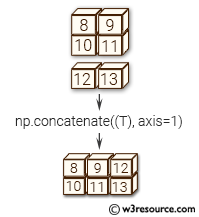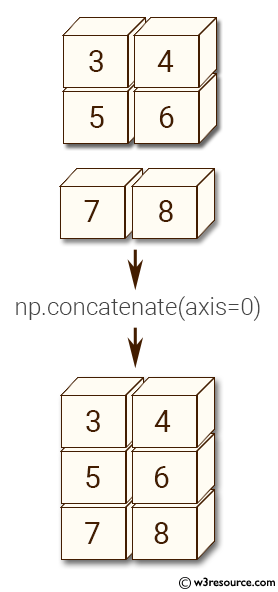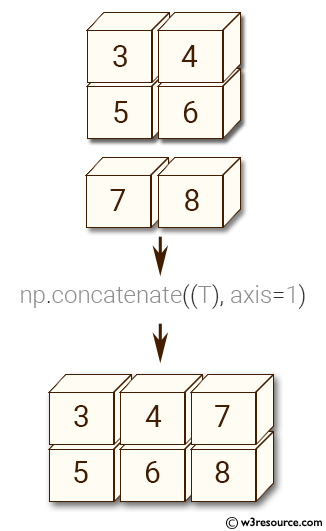NumPy: concatenate() function
numpy.concatenate() function
The concatenate() function returns an ndarray of the provided type that satisfies requirements.
Syntax:
numpy.concatenate((a1, a2, ...), axis=0, out=None)

Version: 1.15.0
Parameter:
| Name | Description | Required / Optional |
|---|---|---|
| a1,a2 | The arrays must have the same shape, except in the dimension corresponding to axis (the first, by default). | Required |
| axis | The axis along which the arrays will be joined. If axis is None, arrays are flattened before use. Default is 0. | Optional |
| out | If provided, the destination to place the result. The shape must be correct, matching that of what concatenate would have returned if no out argument were specified. | Optional |
Return value:
res : ndarray - The concatenated array.
Example-1: numpy.concatenate()
>>> import numpy as np
>>> x = np.array([[3, 4], [5, 6]])
>>> y = np.array([[7, 8]])
>>> np.concatenate((x,y), axis=0)
array([[3, 4],
[5, 6],
[7, 8]])
Pictorial Presentation:

Example-2: numpy.concatenate()
>>> import numpy as np
>>> x = np.array([[3, 4], [5, 6]])
>>> y = np.array([[7, 8]])
>>> np.concatenate((x, y.T), axis=1)
array([[3, 4, 7],
[5, 6, 8]])
Pictorial Presentation:

Example-3: numpy.concatenate()
>>> import numpy as w3r
>>> x = w3r.array([[3, 4], [5, 6]])
>>> y = w3r.array([[7, 8]])
>>> w3r.concatenate((x, y), axis=None)
array([3, 4, 5, 6, 7, 8])
Example-4: numpy.concatenate()
>>> import numpy as w3r
>>> x = w3r.ma.arange(5)
>>> x[1] = w3r.ma.masked
>>> y = w3r.arange(3, 7)
>>> x
masked_array(data = [0 -- 2 3 4],
mask = [False True False False False],
fill_value = 999999)
>>> y
array([3, 4, 5, 6])
>>> w3r.concatenate([x, y])
masked_array(data = [0 1 2 3 4 3 4 5 6],
mask = False,
fill_value = 999999)
>>> w3r.ma.concatenate([x, y])
masked_array(data = [0 -- 2 3 4 3 4 5 6],
mask = [False True False False False False False False False],
fill_value = 999999)
Python - NumPy Code Editor:
- New Content published on w3resource:
- HTML-CSS Practical: Exercises, Practice, Solution
- Java Regular Expression: Exercises, Practice, Solution
- Scala Programming Exercises, Practice, Solution
- Python Itertools exercises
- Python Numpy exercises
- Python GeoPy Package exercises
- Python Pandas exercises
- Python nltk exercises
- Python BeautifulSoup exercises
- Form Template
- Composer - PHP Package Manager
- PHPUnit - PHP Testing
- Laravel - PHP Framework
- Angular - JavaScript Framework
- Vue - JavaScript Framework
- Jest - JavaScript Testing Framework
